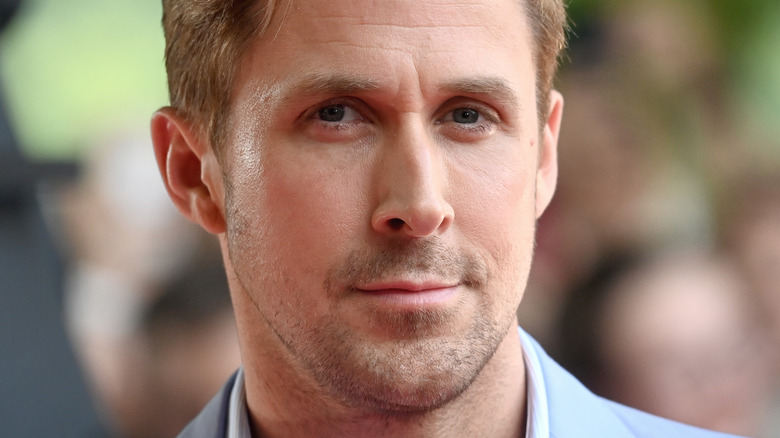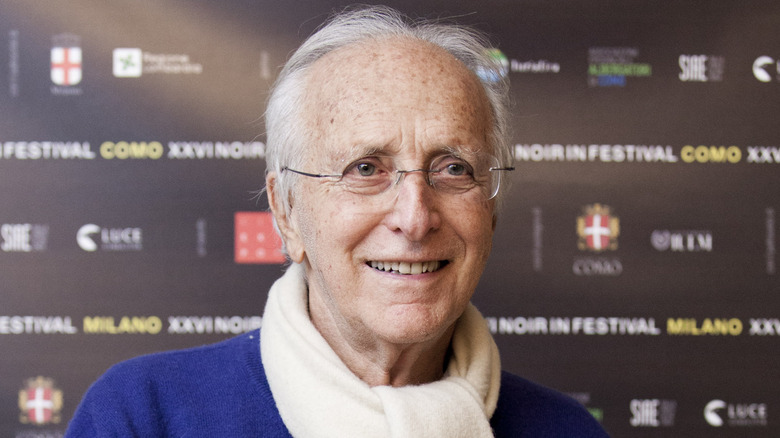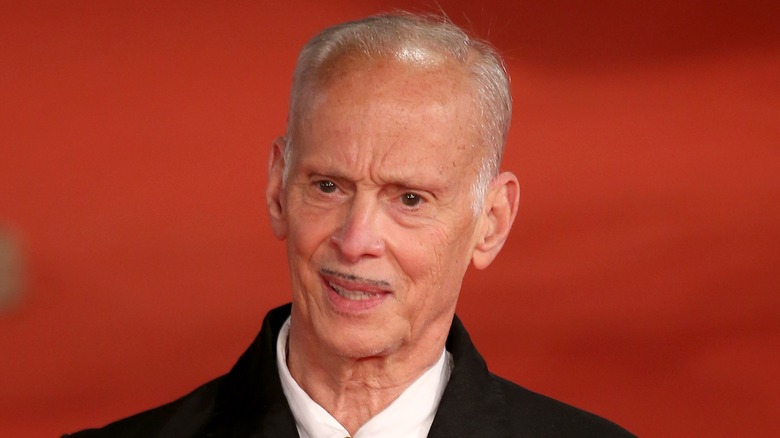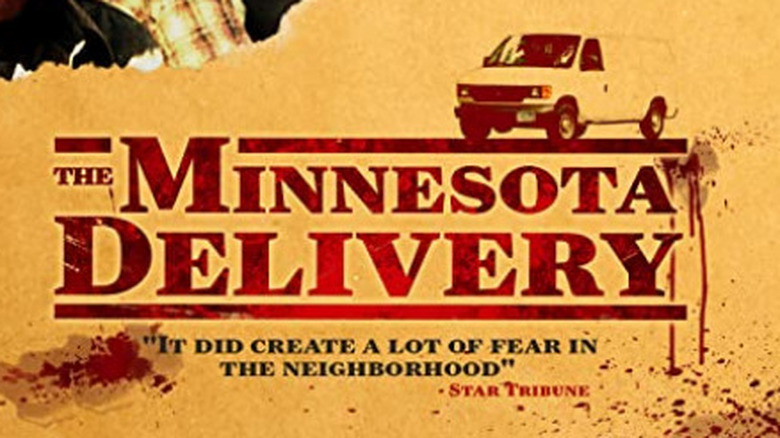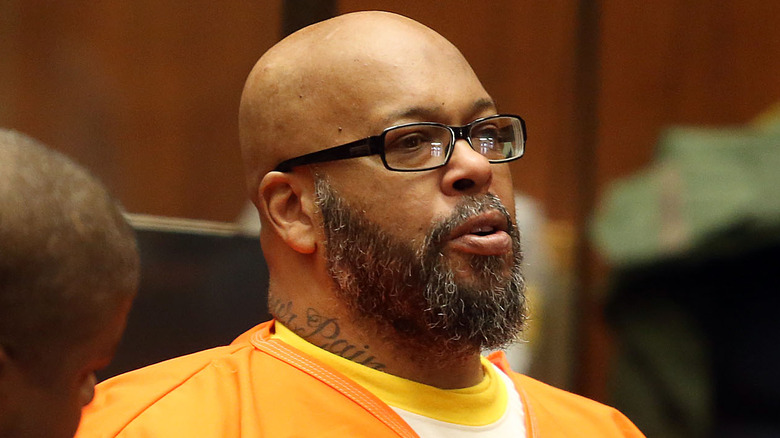Hollywood Stars Who Were Arrested For Their On-Set Actions
Movie and television sets, either on a soundstage or on location, may seem glamorous and exciting, but they are essentially places of business where the entertainment industry creates its product. And like all places of business, crimes occasionally take place there. Some of these on-set incidents are minor offenses, and in some cases, they're major felonies involving controlled substances, illegal finances, and on very rare occasions, bodily harm and even death.
Whether a crime occurs at a corner store or a movie studio, the job of the police is the same: investigate and if possible, detain possible suspects. On a film or TV set, suspects can be members of the production team and even one of the actors. The recent indictment of actor Alec Baldwin on involuntary manslaughter charges has brought to light other incidents in which a performer was taken into custody. Following is a list (with possible spoilers) of the most notorious and unusual instances in which Hollywood stars were arrested for their on-set actions.
Alec Baldwin was indicted for involuntary manslaughter
The death of cinematographer Halyna Hutchins (per The New York Times), who was killed in 2021 when a prop gun wielded by actor Alec Baldwin discharged during the making of the Western "Rust," drew intense scrutiny by both the legal and media professions, who opined furiously over issues of set safety and responsibility in regard to the accident. Baldwin, who was handed what he believed to be a "cold gun" (one without live ammunition), claimed no responsibility in the shooting, sought to avoid financial responsibility for Hutchins' death, and even sued crew members over claims of negligence (via the New York Times). The Times also quoted investigators' interviews with the film's set armorer, Hannah Gutierrez-Reed, who said that she had loaded and checked the gun, but added, "I wish I would've checked it more."
In January 2023, prosecutors in New Mexico, where the "Rust" production was located, announced that they sought to charge Baldwin and Gutierrez-Reed with involuntary manslaughter. Officials also revealed that the prop gun involved in the shooting could not have discharged ammunition without pulling its trigger — which Baldwin has vehemently denied. The new charges re-opened the debate over safety and responsibility in on-set accidents, with Santa Fe County district attorney Mary Carmack-Altwies claiming that Baldwin should have properly checked the gun. However, Baldwin's assertion — that actors have never been responsible for gun safety on sets — is backed by SAG-AFTRA. The union issued a statement that noted, "An actor's job is not to be a firearms or weapons expert." The "Rust" case continues as of this writing.
The Twilight Zone accident changed movie safety rules
While filming a segment for the 1983 anthology film "Twilight Zone: The Movie," actor Vic Morrow and two child performers were killed during a jungle sequence in which Morrow's character and the children run to a waiting helicopter. Though accounts vary on the reason for the accident, the chopper was incapacitated by special effects explosions and plummeted to the ground, killing Morrow, six-year-old Renee Shin-Yi Chen, and seven-year-old Myca Dinh Le.
The tragedy led to indictments (via UPI) for involuntary manslaughter for Landis, special effects supervisor Paul Stewart, and producer George Folsey, as well as unit production manager Dan Allingham and the helicopter's pilot, Dorcey Wingo. The 10-month 1986 trial was closely followed by not only the media but also the film industry itself. In the end, all five defendants were acquitted of the charges; Landis went on to direct "Coming to America" and other projects, though for some defendants, the case spelled the end of their careers.
As Slate noted, John Silva, a vice-president at Warner Bros. (which released "Twilight Zone") was motivated by the accident to create committees that would establish standards for safety during film and television production. With the help of the industry's unions, Silva and the committee laid the groundwork for the Injury and Illness Prevention Program (IIPP), a set of guidelines issued to studios and regularly updated to reflect new standards. Though injuries and even fatalities have continued to occur on movie sets, the IIPP has led to greater attention to safety within the industry.
Sean Penn had several run-ins with police
Though perhaps best known today as an Oscar-winning actor and filmmaker, as well as an outspoken social and political activist, Sean Penn's early career was also marked by a penchant for altercations with the media and the public. The mid-1980s, in particular, saw Penn charged with misdemeanor assault and battery on several occasions, including a fight with an extra on the set of the Dennis Hopper-directed film "Colors" in 1987. According to UPI, an extra on the film, Jeffrey Klein, took photographs of Penn and co-star Robert Duvall during a break in filmmaking in April of that year. Penn reportedly objected and spat at Klein before striking him several times.
The assault charge violated Penn's probation on a previous battery charge, which he had already broken due to misdemeanor charges of reckless driving and driving under the influence of alcohol in May 1987. Municipal Court Commissioner Juelann Cathey sentenced the actor to 60 days in jail for both the assault and reckless driving charges, and imposed an additional two years' probation. The incident would be Penn's last visit to court for such charges until 2009, when he was given 36 months probation and 300 hours of community service for assaulting a photographer (via Reuters).
Detroit police thought Ryan Gosling was stealing copper wire
A chorus of mixed or dismissive reviews (via Rotten Tomatoes) wasn't the only indignity that Ryan Gosling experienced as a result of his 2014 directorial debut with the dreamlike experimental feature "Lost River." Gosling was also arrested while scouting locations for the project in Detroit, Michigan, where he had recently filmed George Clooney's 2011 film "The Ides of March." As a Los Angeles Times feature from 2015 noted, he remained in Detroit after that film's completion and shot HD footage of empty buildings throughout the city that appears in the opening of "Lost River."
While these forays may have helped to inspire Gosling's creative endeavor, it also resulted in him running afoul of Detroit police. According to him, he was arrested at one point by law enforcement, who thought he was trying to steal copper wire from an abandoned location. "I'm not proud that I was arrested," Gosling told the Times, "but it did give me one of the central pieces for the main character [in 'Lost River']." In the film, Iain De Caestecker played a teenager who scrounged burnt-out buildings for wire in order to help his mother (Christina Hendricks) make ends meet.
Randall Miller was jailed for involuntary manslaughter on Midnight Rider
The 2014 death of camera assistant Sarah Jones on the set of "Midnight Rider" made director Randall Miller the only filmmaker in motion picture history to receive a prison sentence for an on-set fatality. Jones was struck and killed by a train on the first day of filming on "Rider," a biopic of rocker Gregg Allman. Charges of criminal trespassing and involuntary manslaughter were filed against Miller, his wife, producer Jody Savin, and two other members of the production team. In exchange for dropping the charges against Savin, Miller agreed to a plea deal that sentenced him to two years in jail and eight years of probation.
Miller spent a year behind bars before his release in 2016, though Deadline reported that he returned to court in 2021 for violating one of the terms of his probation, which was to refrain from directing films until the completion of his sentence. Miller directed the 2019 feature "Higher Grounds," but avoided jail time because he thought he was only forbidden from overseeing any safety precautions on the production.
As Deadline noted in 2015, more than 80 people have died due to on-set accidents in the past century of filmmaking. But prior to Miller's conviction, only two people had been prosecuted on such charges: Pathe Film Studio vice president John C. Flinn and production manager Harry Lalley, who were indicted for second-degree manslaughter when a fire at the studio killed 10 people in 1929. Both charges were later dismissed by the New York Court of Appeals.
George Romero was arrested for a homemade special effect
Before he helped to revolutionize the modern horror movie with his zombie films, including "Night of the Living Dead" and "Dawn of the Dead," writer-director George A. Romero was a boy living in New York City and dreaming of making a career in the movies. He was inspired in part by British director Michael Powell's vibrant fantasy "Tales of Hoffman," of which he later said (via RogerEbert.com), "That made me feel that, gee, maybe I could figure this medium out." Like countless other would-be filmmakers, Romero borrowed a camera and began experimenting with his own movie projects.
One of his earliest efforts, a 8mm science fiction film called "The Man from the Meteor," also led to an arrest when he was 14 years old and living in the Parkchester neighborhood of the Bronx. As he told NPR in 1988, "The man from the meteor was ultimately shot with his own ray gun and fell flaming off the roof where I lived." To complete the shot, Romero lit a dummy on fire and threw it off the top of a building without obtaining permission from the New York Police Department, who quickly arrested the teenage Romero. "I was hauled away by the police and my parents were called," he said. "It wasn't a serious arrest. I didn't have to spend the night in jail or anything."
Ruggero Deodato was accused of killing his actors
Director Ruggero Deodato's 1980 horror-exploitation film "Cannibal Holocaust" helped to create the found-footage subgenre. It presented an extremely convincing but entirely fake documentary that showed a party of rogue filmmakers tormenting indigenous people and animals in the Amazon jungle before receiving a gruesome comeuppance at the hands of a cannibalistic tribe. The film's extreme violence — which unfortunately included some real animal deaths — looked so convincing to authorities in his native Italy that Deodato was charged with murdering his cast members and faced a 30-year sentence.
Charges were dropped after Deodato produced the actors who played the four slain filmmakers in "Cannibal Holocaust," though he still received a four-month suspended sentence on obscenity charges and, according to The Guardian, fined for animal cruelty. "Cannibal Holocaust" was banned in Italy until 1984, and remains available only in edited form (via Collider) in many countries, including the United Kingdom and New Zealand.
A nude hitchhiker earned John Waters a court date and notoriety
Before filmmaker John Waters inspired the well-loved and Tony Award-winning Broadway musical "Hairspray" with his 1988 film of the same name, he was best known for a string of transgressive underground films like "Pink Flamingos," "Female Trouble," and "Polyester." Waters's early films skewered notions of gender, class, and politics with a gleeful mix of bad taste and anarchic humor, which often ran afoul of censor boards (via Sage Journals). It also landed him in hot water with the police in his hometown of Baltimore, Maryland during the making of his 1969 film "Mondo Trasho."
In his hilarious 1981 memoir "Shock Value," Waters explained that "Trasho," which was his first feature-length film, featured a scene in which his frequent star, the formidable drag performer Divine, encountered (and ran over) a nude male hitchhiker. Waters decided to film the scene on the campus of Johns Hopkins University, which resulted in his arrest for "conspiracy to commit indecent exposure" and accusations that he and his friends were making pornography.
The ever-shrewd Waters contacted the American Civil Liberties Union for his defense, and the resulting trial earned coverage in Variety and other major publications. According to Waters, he helped to blow apart the district attorney's case by screening one of his early films, "Hag in a Black Leather Jacket," which proved trashy and self-consciously arty but definitely not obscene. "They were so disappointed," Waters told the Johns Hopkins Hub in 2014.
Tim Christian's improvised action scene brought the cops
"A spur of the moment" was how indie filmmaker Timothy Christian described his decision to use a quiet neighborhood in St. Paul, Minnesota as the setting for a major action sequence in his 2013 action-drama "The Minnesota Delivery." Unfortunately, Christian's burst of inspiration also caused him to forget two important facts: permits are usually required to shoot a movie in a residential area, and homeowners tend to freak out at the sight of armed strangers running amok on their lawns. Both of these factors brought the St. Paul police to the North End neighborhood on September 27, 2013, where according to investigators' reports (via the Twin Cities Pioneer Press), they found "four individuals ... some armed with handguns, taking cover behind a vehicle while pointing the weapon."
Christian and three of his actors were held in jail for about 48 hours but were never charged, They eventually recovered their equipment, including his digital camera and footage of the action scene. "We ended up using the shot," he told the Pioneer Press. "I think it was worth it." The footage wasn't the only souvenir from his run-in with the police: Christian also used a quote from a police officer ("It did create a lot of fear in the neighborhood"), taken from the Minnesota Star Tribune, on the film's promotional material.
Remy Couture was almost jailed for his gory FX
As we've seen, horror filmmakers who create ultra-violent media can sometimes land in legal hot water. Canadian special effects artist Remy Couture learned this firsthand in 2009 when he was arrested after a complaint was made to Interpol about the content on his website, Inner Depravity, which featured images and video depicting gruesome murders and other shocking acts. According to the CBC, Couture, who also worked on studio features like "Punisher: War Zone," faced three counts of corrupting morals by distributing, possessing, and producing obscene materials.
Couture pled not guilty to the charges in 2010 and testified at the trial that his website was a showcase for his horror-oriented special effects, while also denying allegations that his work was violent pornography. Prosecutors introduced experts to support their position that Couture's work "undermines fundamental values of Canadian society" and could inspire unbalanced individuals to imitate the grisly setpieces. But as Couture told the court, "My objective was to create horror, plain and simple." Defense attorneys brought their own experts, including criminology professor Marc Ouimet, who stated that there was no proven link between pornography and violent acts.
After three years in legal turmoil, Couture was found not guilty of all charges. "It's like a 400-pound weight has been lifted," he said to the press outside a courthouse in Montreal. "It's been the most stressful thing I've ever had to go through in my life."
The three-strikes law put Suge Knight away for a hit-and-run
As the co-founder and CEO of Death Row Records, Marion "Suge" Knight was a powerhouse in the 1990s gangsta rap scene, overseeing chart-topping releases by artists like Dr. Dre, Snoop Dogg, and Tupac Shakur. Knight also had a reputation for ruthlessness and was reportedly linked to the deaths of Shakur and the Notorious B.I.G., two groundbreaking rappers whose murders remain unsolved to this day.
In 2015, Knight was charged (via CBS News) with murder, attempted murder, and hit-and-run after an altercation with two men that began on the set of "Straight Outta Compton," a feature about the pioneering rap group N.W.A., of which Dr. Dre was a founding member. After feuding with record label owner Terry Carter and Cle Sloan, a consultant on "Compton," Knight followed the men in his car to a restaurant near the film's set. Video taken at the scene showed Knight's car running over Sloan twice and then hitting Carter, who later died of his injuries.
Knight was out on bail in a robbery case at the time of the accident that, in addition to previous convictions, made him ineligible due to California's "three strikes" law. Facing the possibility of a life sentence, Knight pleaded no contest (via USA Today) to the manslaughter charge in September 2015 and agreed to serve 28 years in prison. According to the California Department of Corrections and Rehabilitation, Knight will not be eligible for parole until 2034.
